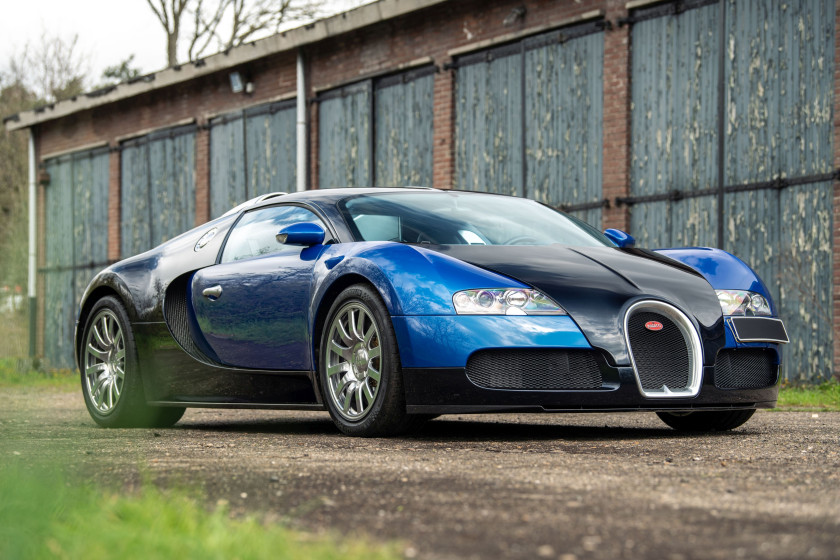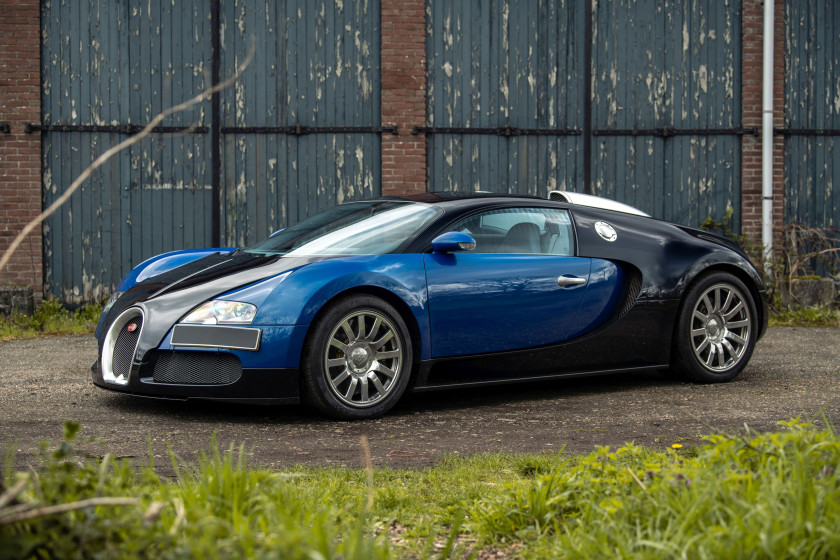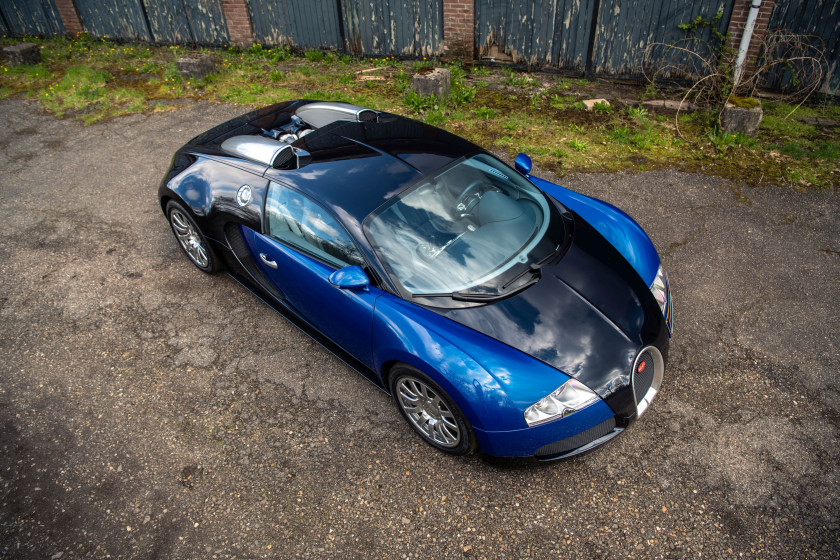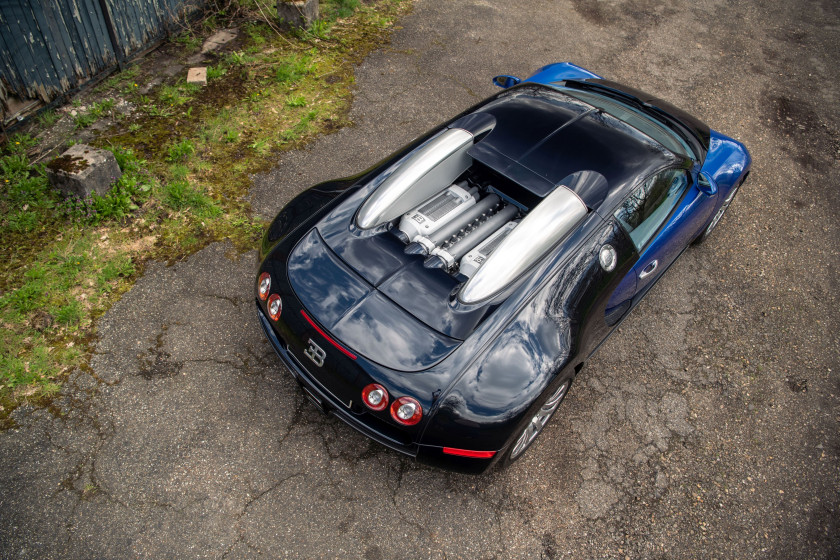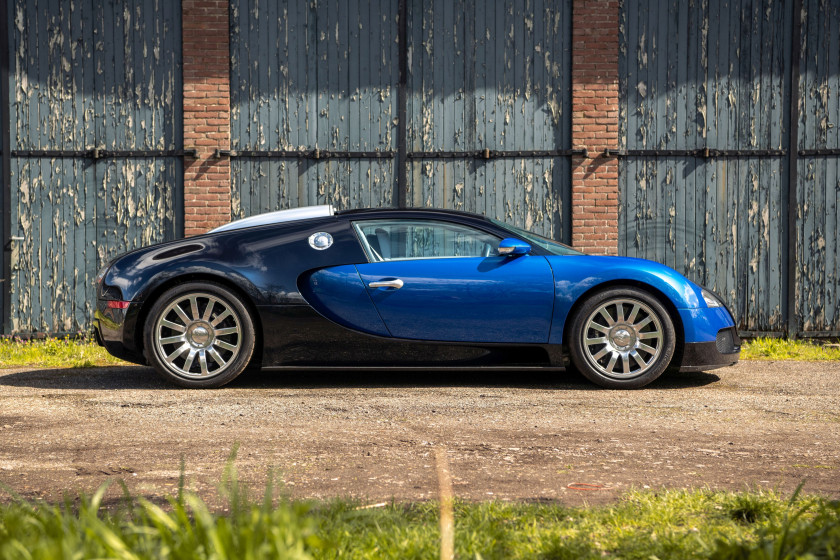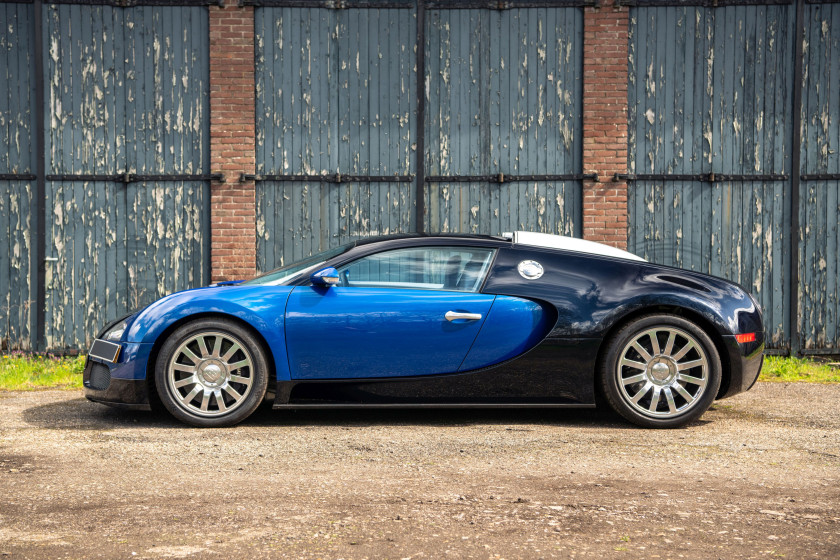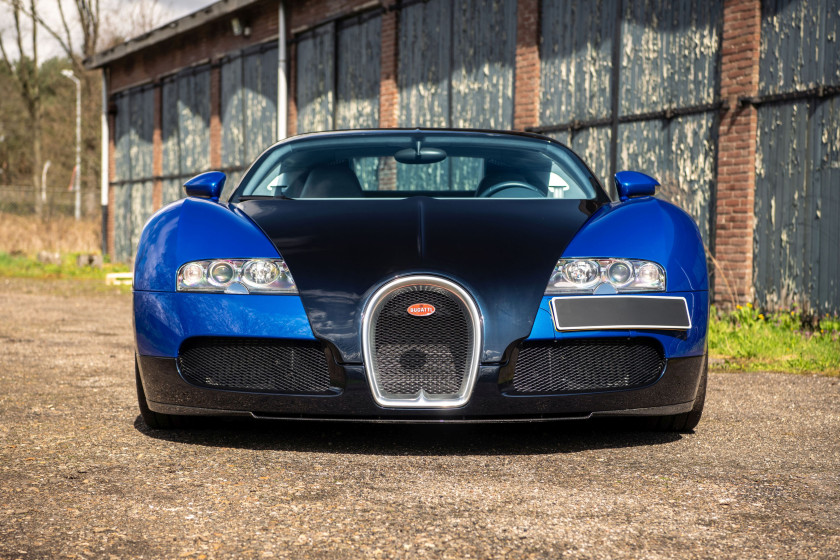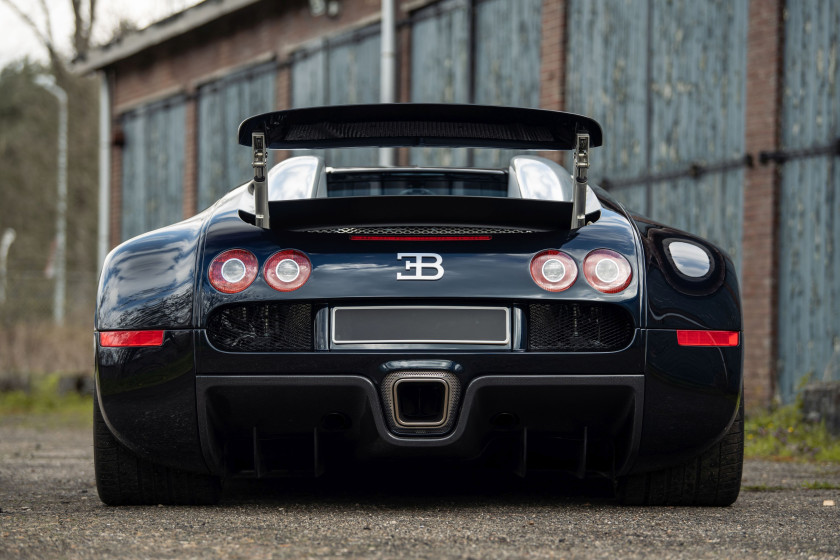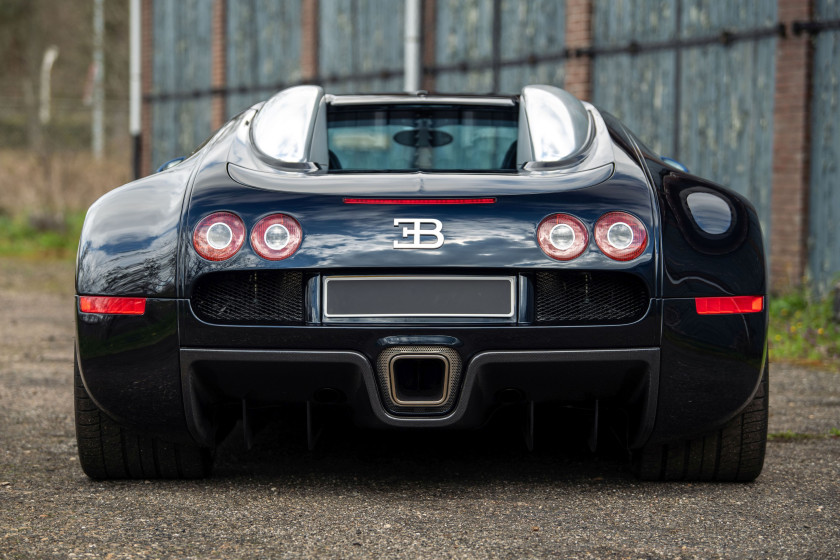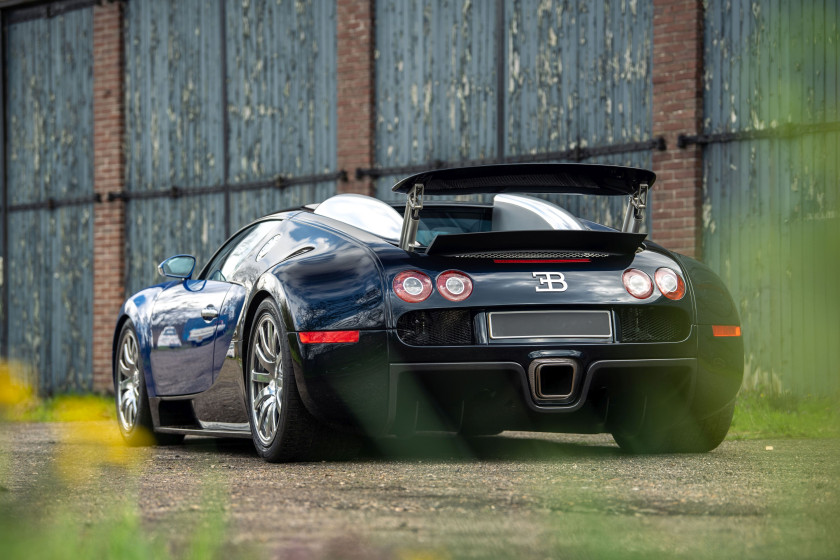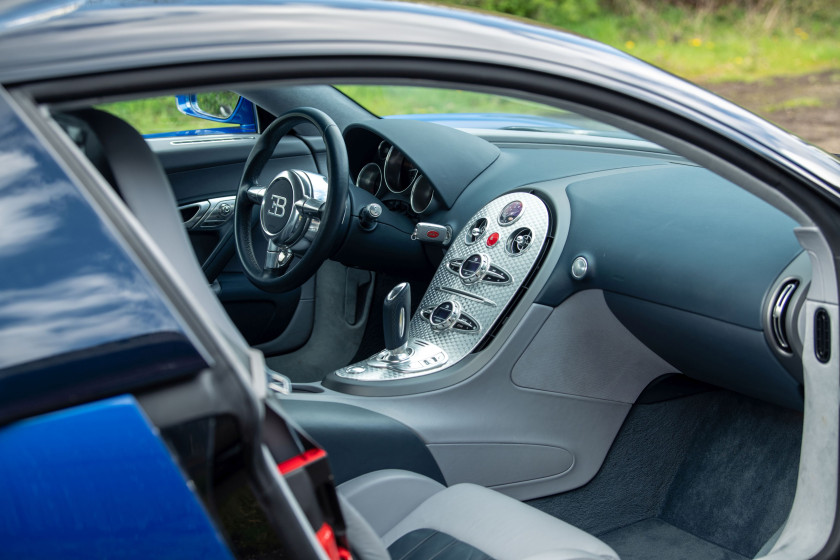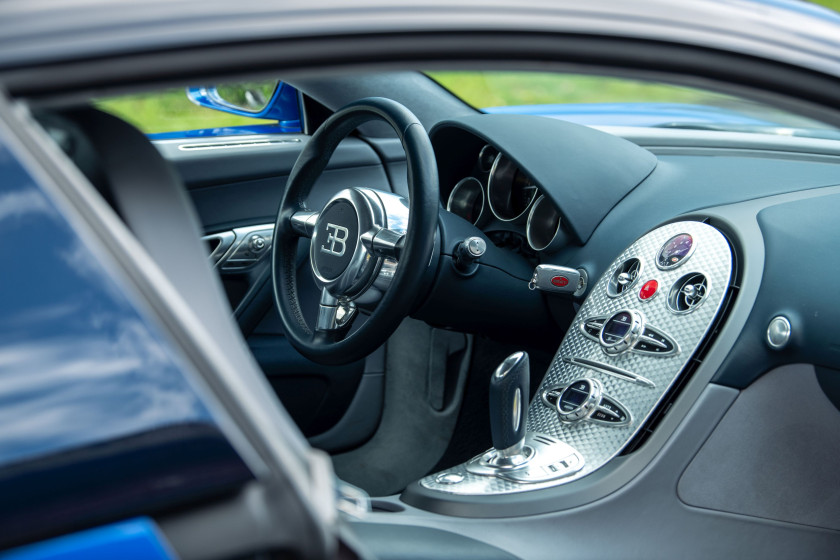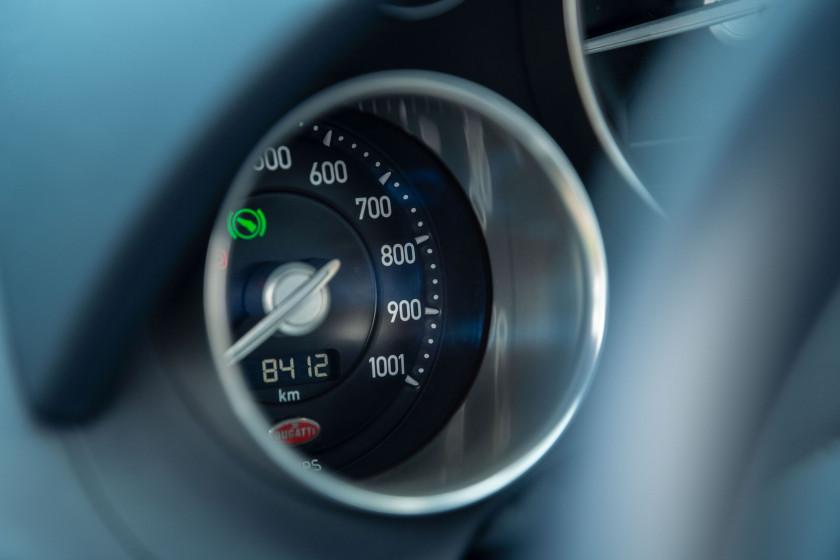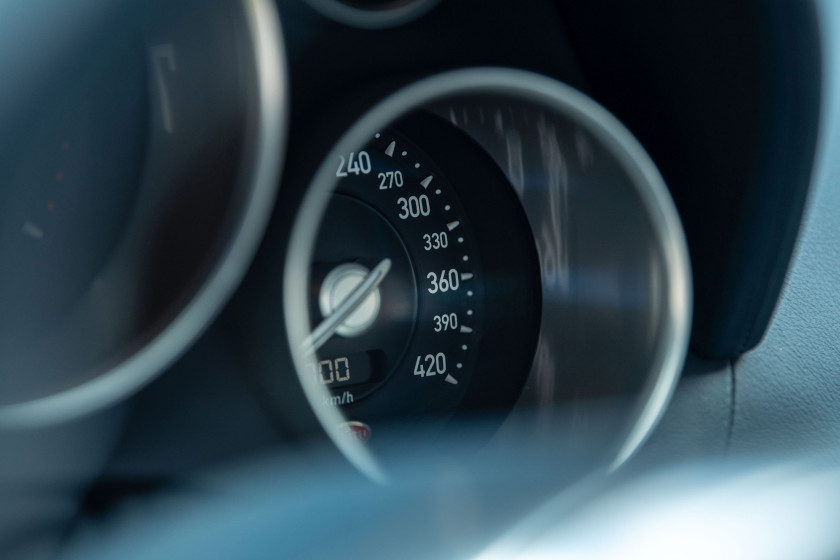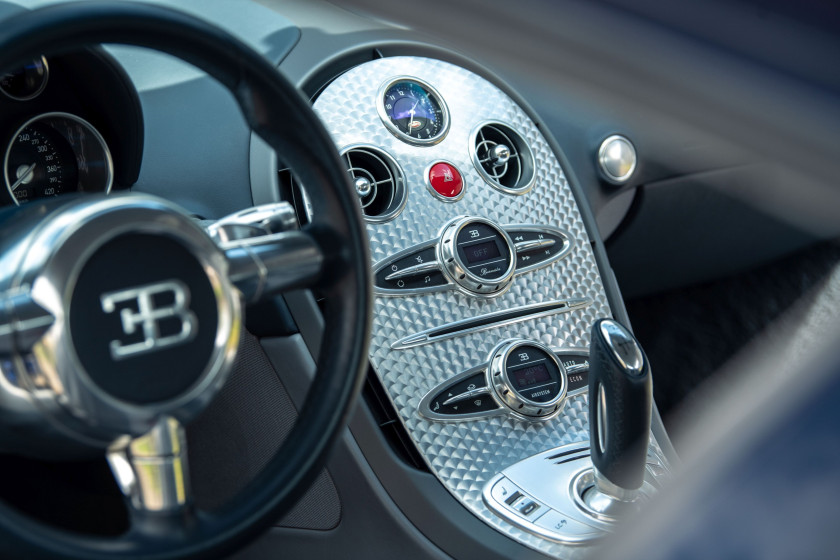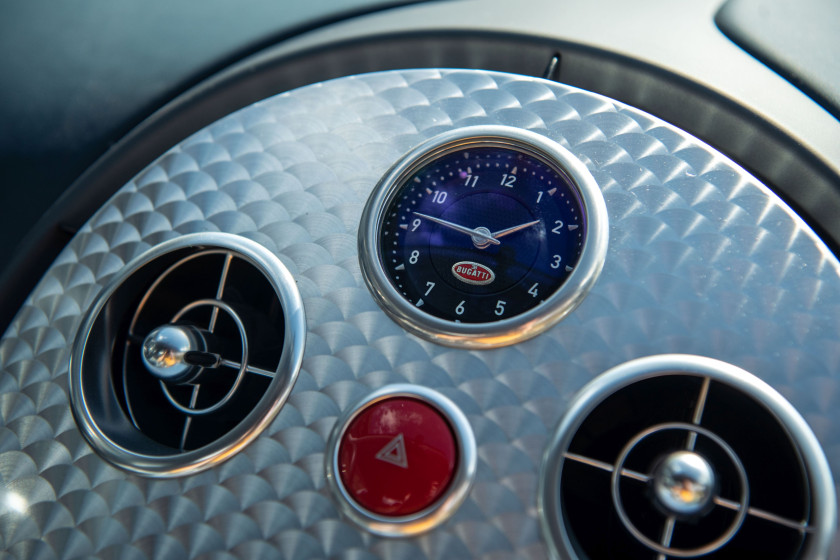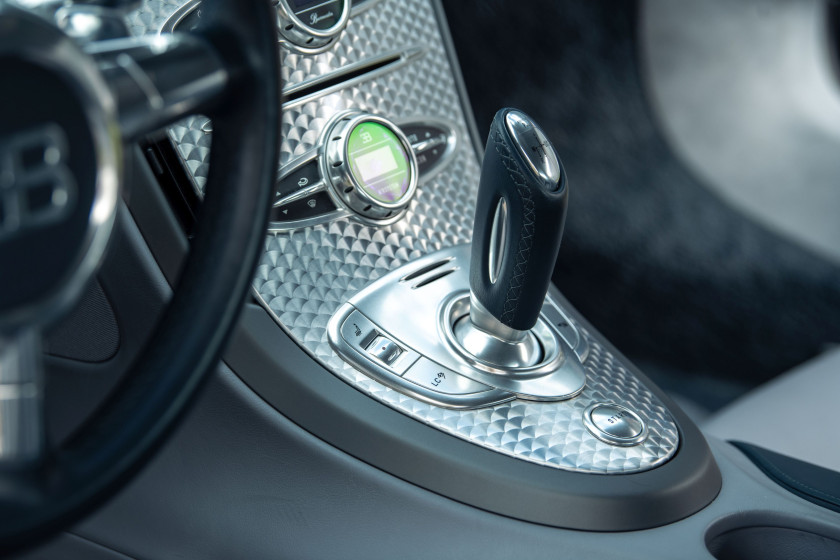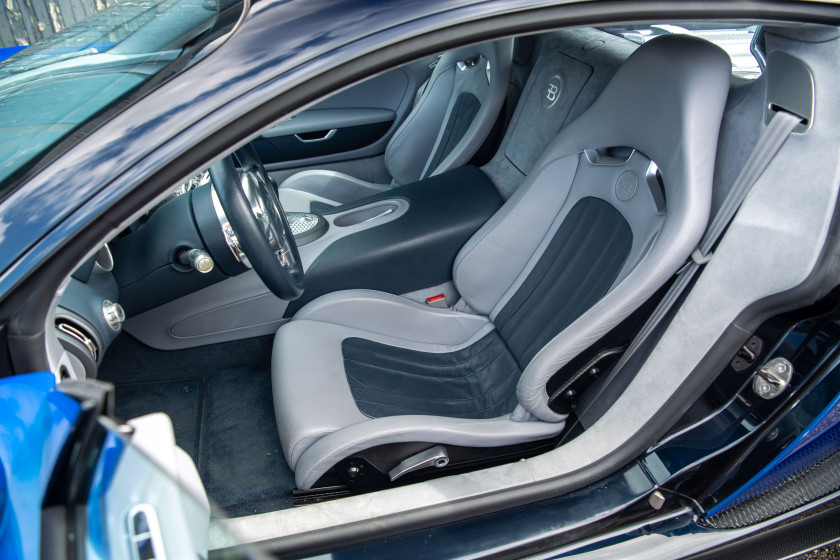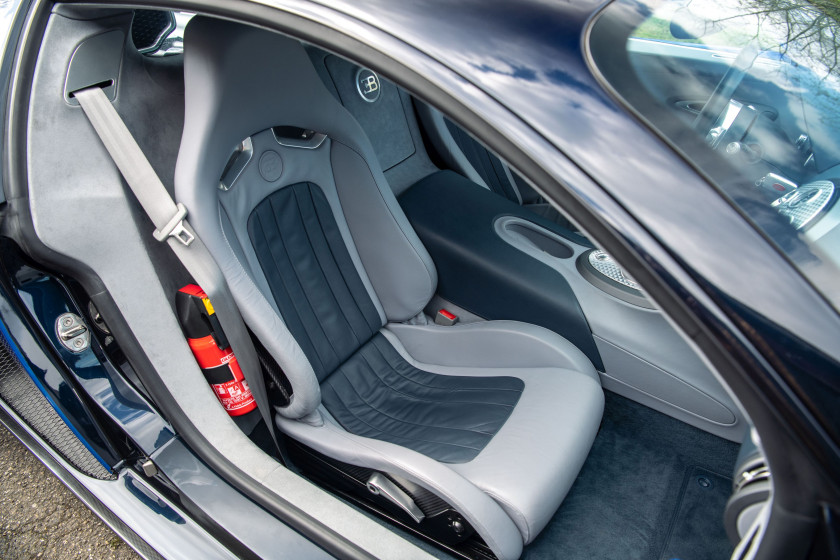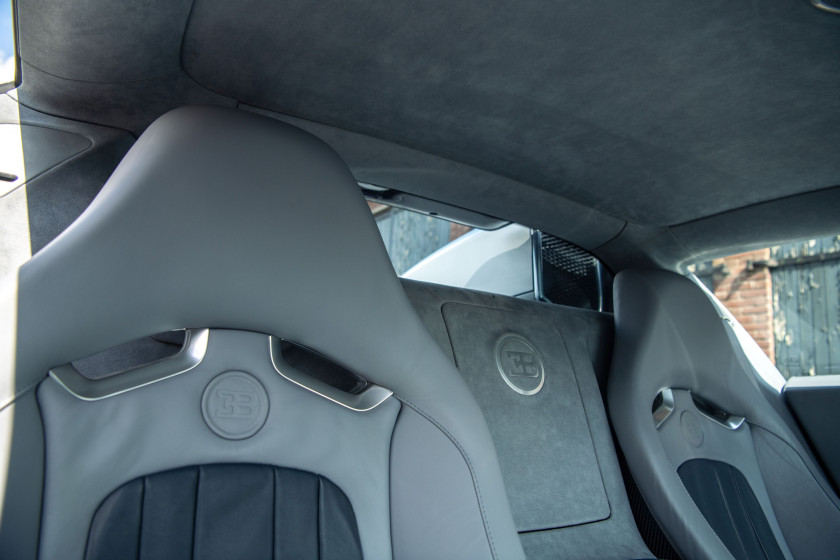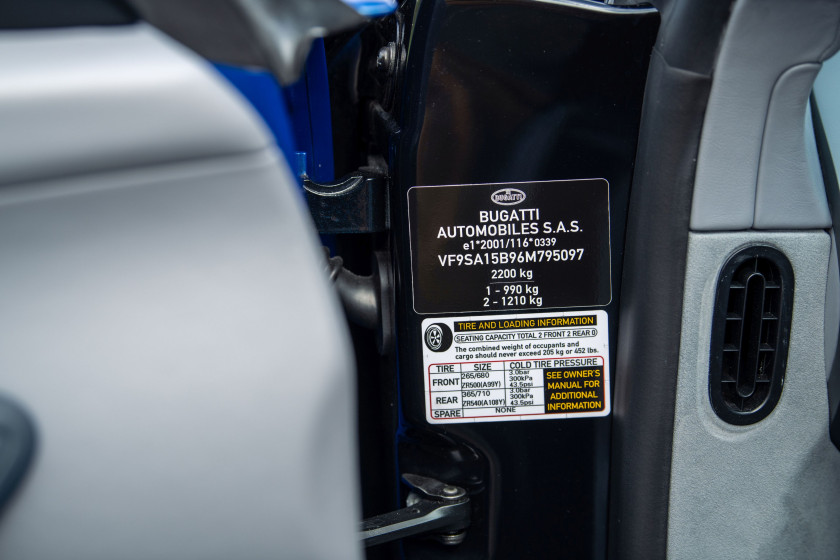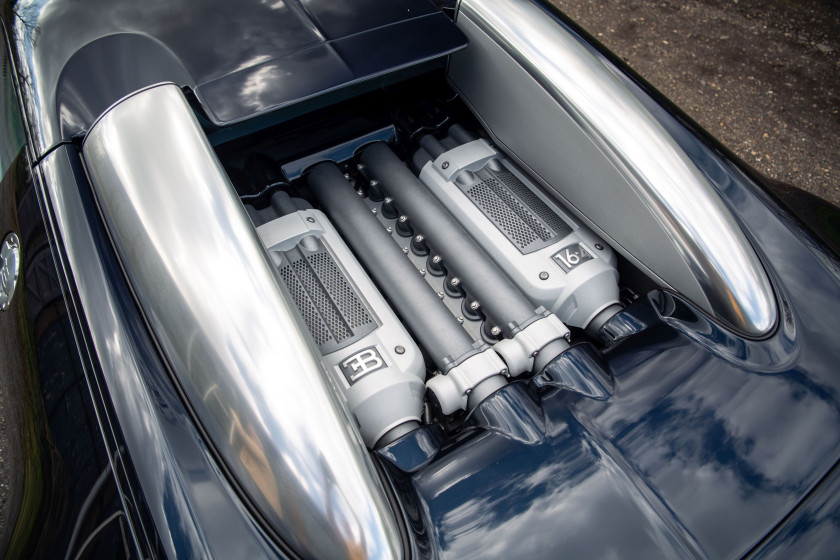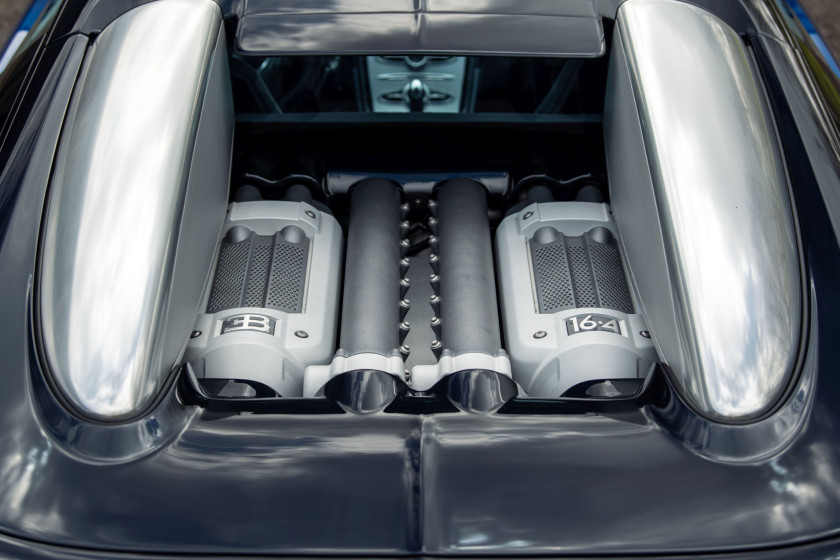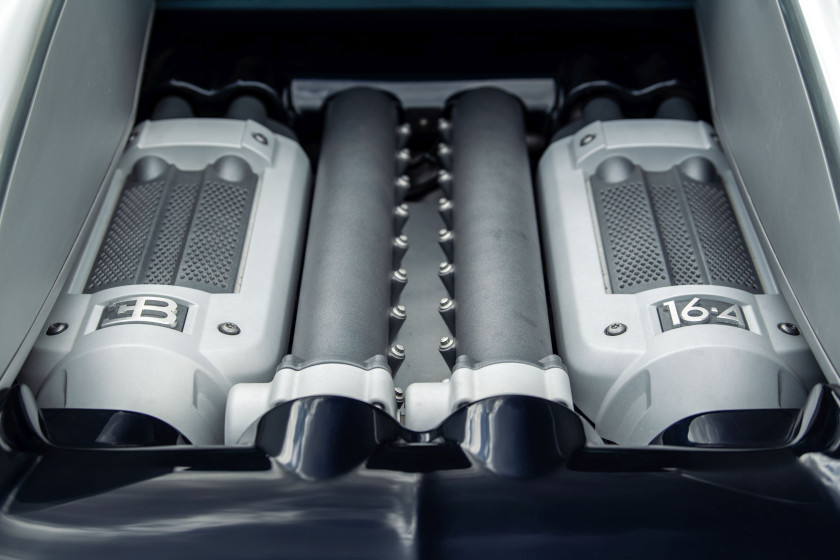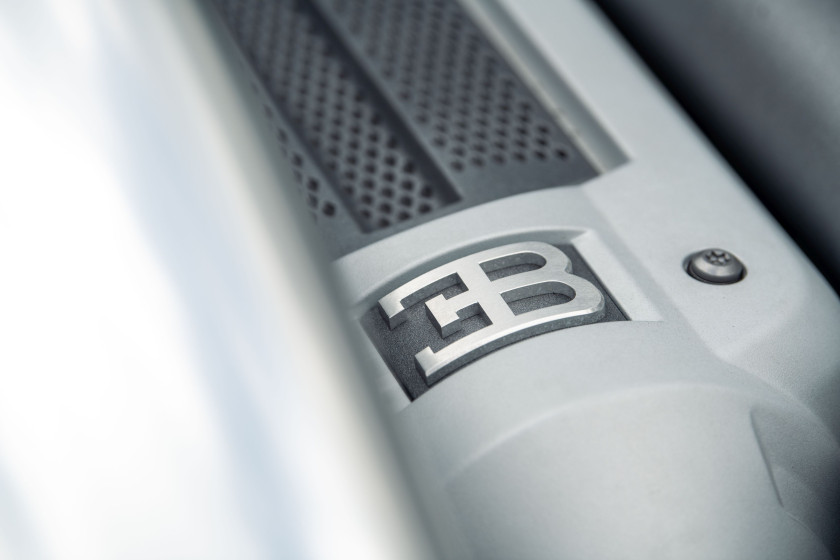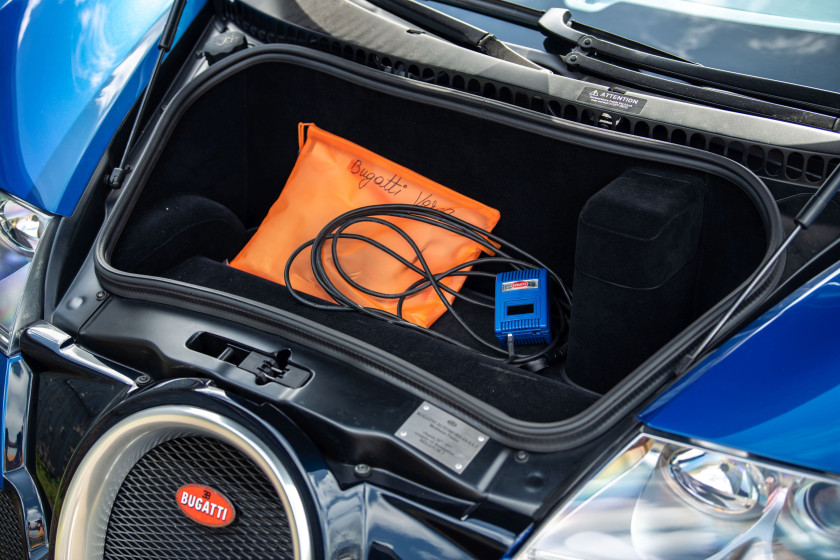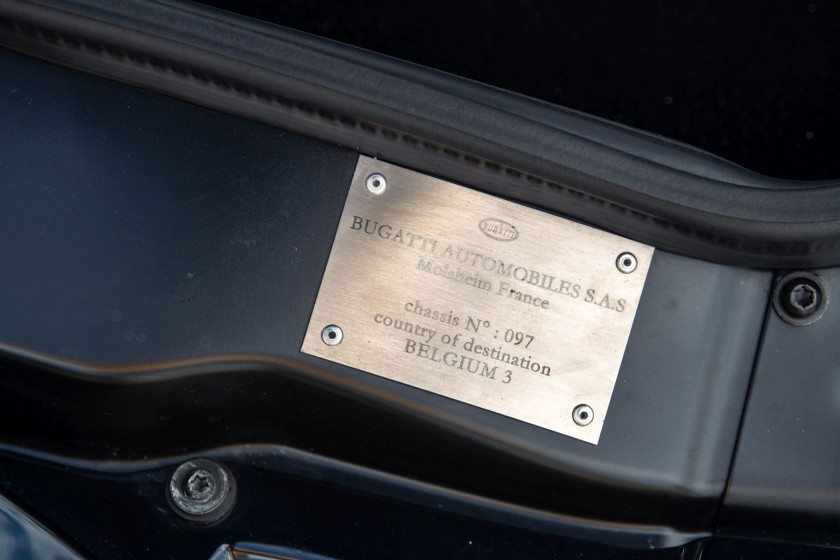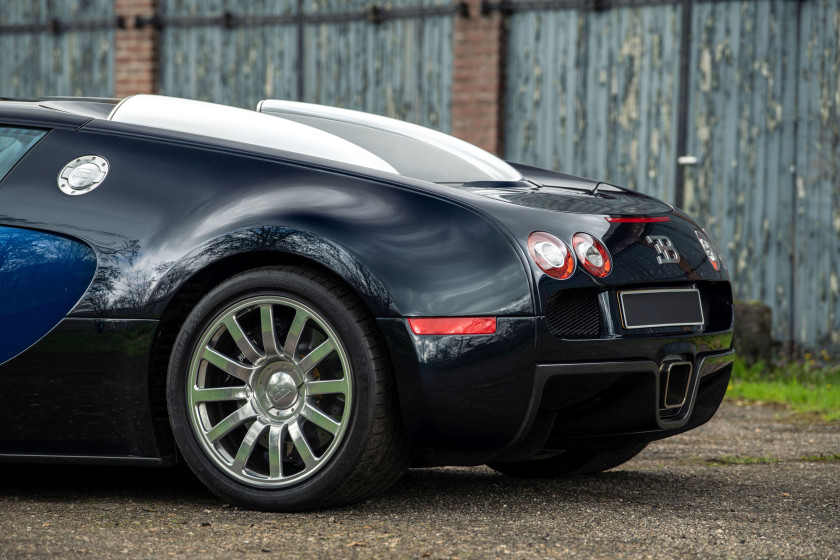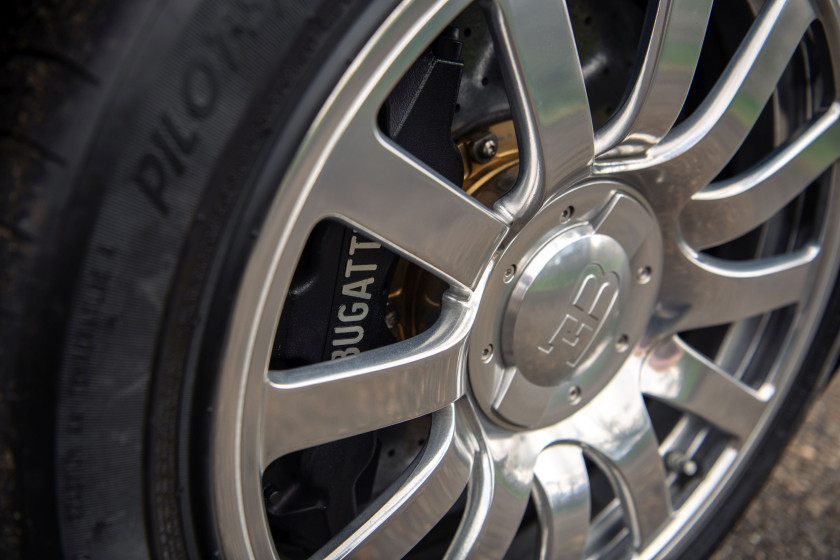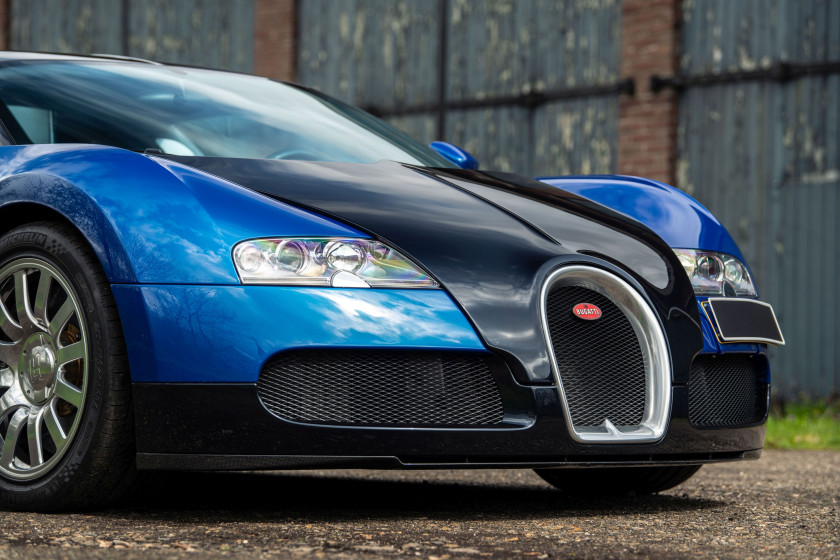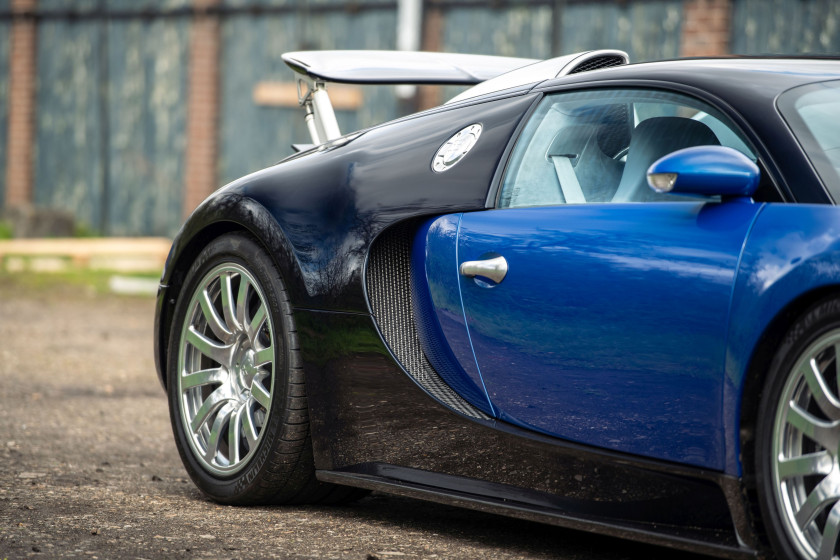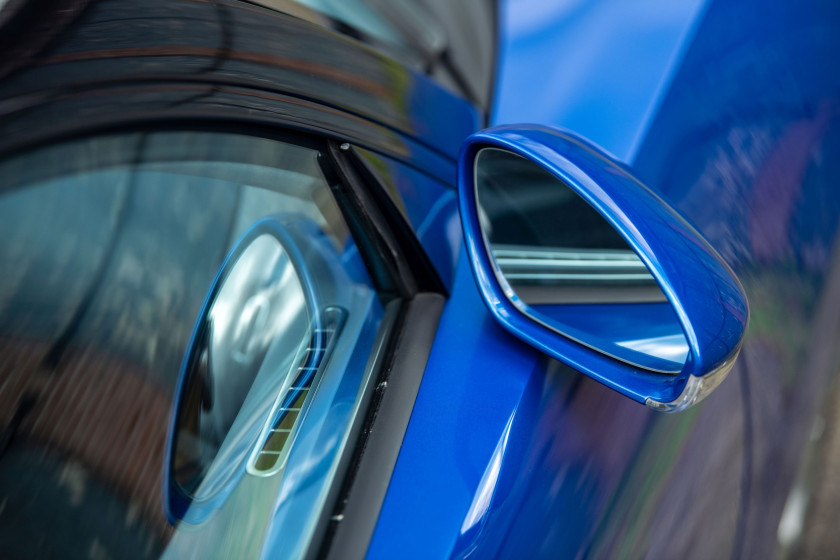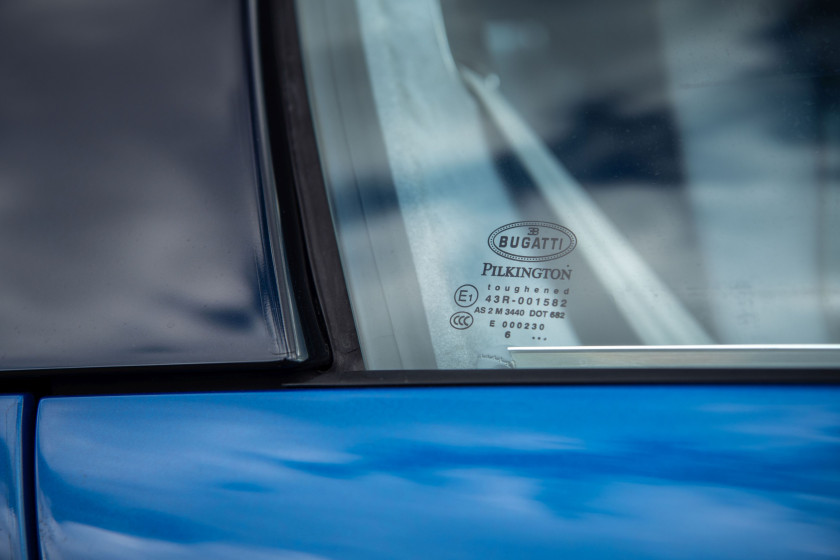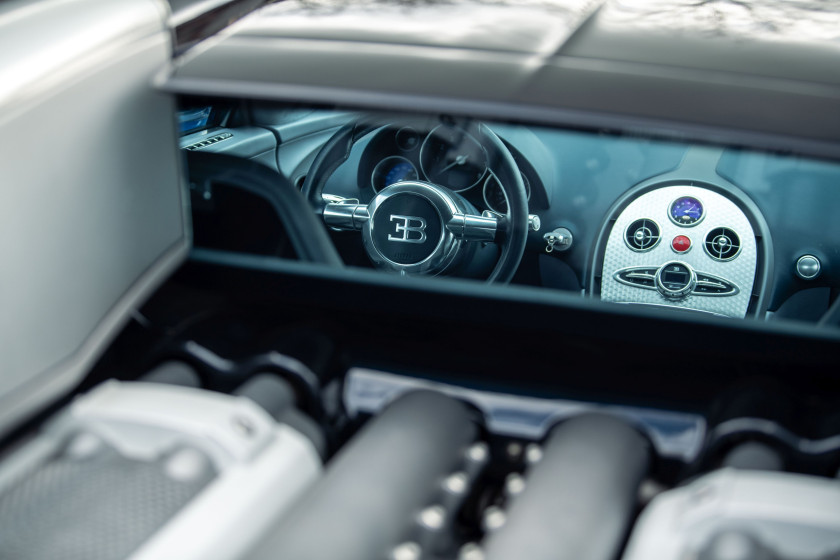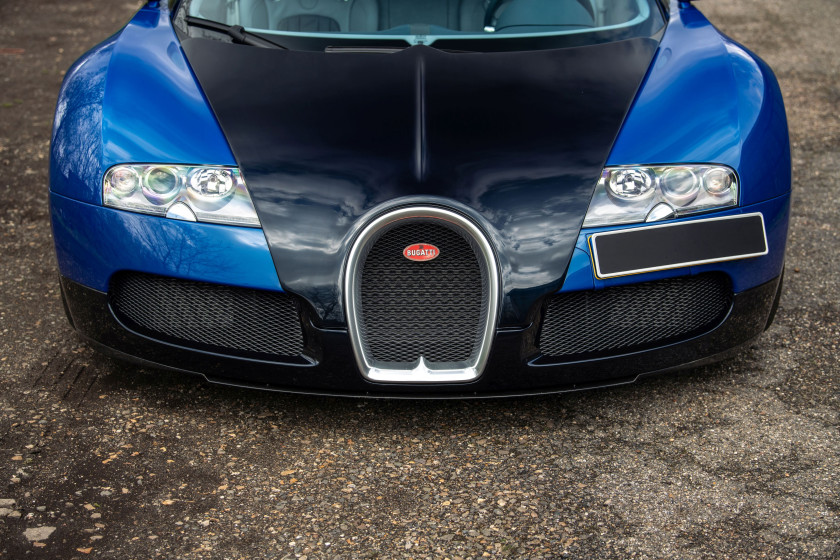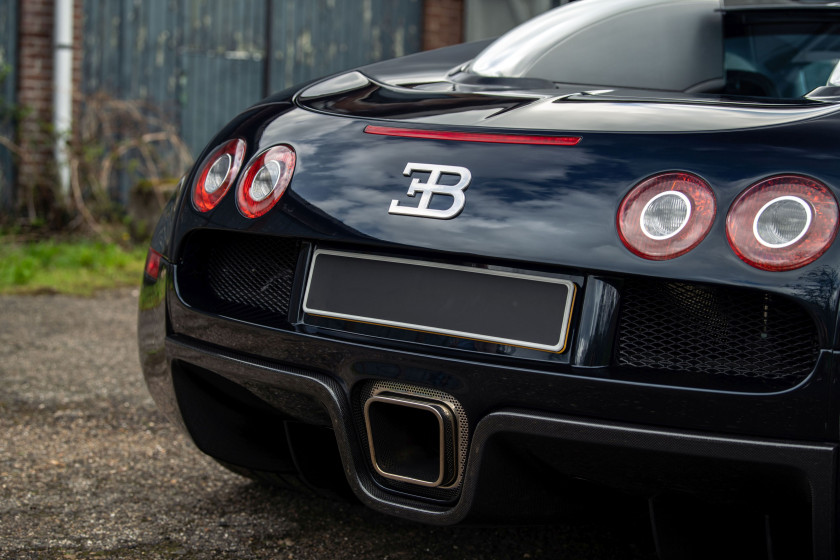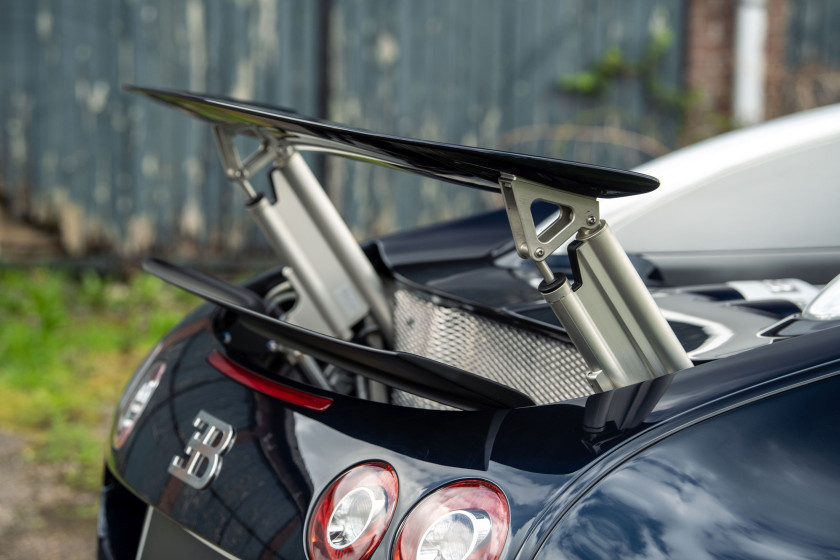Vente Le Mans Classic 2023 - 30 juin 2023 /Lot 76 2007 Bugatti Veyron 16.4
2007 Bugatti Veyron 16.4
Collection d'un passionné de Supercars
Titre de circulation hollandais
Châssis n° VF9SA15B96M795097
- Premier jalon de la renaissance de Bugatti
- Performances ahurissantes
- 8 412 km d'origine
- Entretien récent à l'usine, historique et suivi connus
La Bugatti Veyron est née des ambitions de Ferdinand Piëch alors qu'il était à la tête du groupe VAG. Après le rachat de la marque Bugatti en 1998, la Veyron avait été présentée au Mondial de l'Automobile de Paris en 2000 et Piëch avait annoncé qu'elle " serait la voiture commercialisée la plus rapide du monde, avec un moteur de 1 000 ch et une vitesse de pointe de 400 km/h. " Il a fallu cinq ans aux ingénieurs de VAG pour atteindre cet objectif extrêmement ambitieux et, en avril 2005, les premiers exemplaires de cette prestigieuse machine étaient enfin livrés. Pour obtenir ces performances hors du commun, Bugatti avait mis au point un moteur W16 composé de deux V8 à angle très fermé, de 8 litres de cylindrée et doté de quatre turbocompresseurs. Quatre radiateurs, quatre ventilateurs et 55 litres de liquide de refroidissement se chargeaient de maintenir l'ensemble à la température adéquate, même lors de la circulation dans un embouteillage en plein été.
La transmission était composée d'une boîte séquentielle conçue spécialement pour pouvoir assimiler une telle puissance et les quatre roues étaient motrices. Même les pneus avaient fait l'objet d'une étude particulière et Michelin avait pu répondre au cahier des charges en mettant au point une gomme permettant d'atteindre 440 km/h et de rouler même en cas de crevaison. Quant au freinage, il était confié à des disques de carbone/céramique et des étriers en titane de huit pistons à l'avant et six à l'arrière. L'ensemble était logé dans une structure en fibre de carbone sur laquelle se greffaient des berceaux avant et arrière en aluminium et acier, et des éléments de carrosserie en aluminium. L'aérodynamique avait évidemment fait l'objet d'un travail considérable : la garde au sol diminuait à partir d'une certaine vitesse et un aileron arrière se déployait. Une fonction " launch control " permettait d'effectuer des départs arrêtés dans les meilleures conditions. D'ailleurs, les accélérations étaient particulièrement spectaculaires, la voiture passant de 0 à 100 km/h en 2,5 s, et atteignant 200 km/h en 7,3 s. A tous points de vue, cette voiture était donc une exception et n'avait lors de son lancement pas d'équivalent sur le marché. Après un premier prototype nommé Chiron et dessiné par Giugiaro, la forme de la Veyron avait été confiée à Helmut Warkuss, styliste responsable du design chez Volkswagen. Elle reprenait des traits de style propres à la marque de Molsheim, comme la calandre en fer à cheval et la découpe latérale formant prise d'air.
Cette Bugatti Veyron est un des 81 exemplaires sorti des usines de Molsheim en 2007, la production totale du modèle s'élevant à seulement 252 unités.
Son premier propriétaire, un amateur belge, l'a immatriculée le 25 avril 2007, et une plaque fixée dans le compartiment avant rappelle qu'il s'agit de la 3ème Veyron produite à destination de la Belgique. Sa ligne époustouflante est mise en valeur par une combinaison de couleurs qui mêle habilement le noir bleuté métallisé et le bleu métallisé. L'habitacle présente, quant à lui, un luxe inouï, avec ses sièges sport optionnels en cuir matelassé noir et gris, ses compteurs à cerclages d'aluminium, avec le compte tour au centre, le compteur gradué jusqu'à 420 km/h et le compteur de puissance qui culmine à 1001 cv ! La console centrale reprend l'apparence de l'aluminium bouchonné en hommage aux tableaux de bord Bugatti Grand Prix des années 20 et l'on retrouve également les initiales " EB " sur le moyeu du volant à trois branches ou encore sur les sièges baquet. Immatriculée en 2019 aux Pays-Bas et totalisant 8 412 km lors de notre examen, la voiture a bénéficié d'une révision chez Bugatti en novembre 2022 alors qu'elle affichait 8 382 km. La facture de près de 29 000€ sera remise à l'acheteur.
Pierre angulaire de la renaissance de la marque Bugatti, la Veyron est une des créations automobiles les plus extravagantes du début du 21ème siècle, cet exemplaire en état exceptionnel, avec une combinaison de couleurs d'une grande élégance et un kilométrage très limité est une véritable œuvre d'art, prête à prendre la route.
Collection of a supercars enthusiast
Dutch title
Chassis n° VF9SA15B96M795097
- First major milestone in Bugatti's revival
- Staggering performance
- 8,412 km from new
- Recent factory service, known history and records
The Bugatti Veyron was born from the ambitions of Ferdinand Piëch when he was in charge of the VAG group. Following the Bugatti takeover in 1998, the Veyron was presented at the Paris Motor Show in 2000, with Piëch announcing that it " would be the fastest production car in the world, with a 1 000 bhp engine and a top speed of 400 km/h ". It took five years for the engineers at VAG to achieve this extremely ambitious goal, and the first examples of this prestigious machine were finally delivered in April 2005. To obtain such an extraordinary performance, Bugatti developed an 8-litre W16 engine built using two narrow-angle V8 engines. It was fitted with four turbochargers, and required four radiators, four fans and 55 litres of coolant to maintain the correct temperature, and avoid problems if caught in traffic on a summer's day.
The transmission featured a sequential gearbox, designed to manage the power, and four-wheel drive. Even the tyres were developed specially by Michelin, to cope with speeds of up to 440 km/h, and with a run-flat feature. The carbon-ceramic brake system had eight titanium pistons at the front and six at the back. The car was constructed with a central carbon fibre tub attached to front and rear aluminium and steel cradles, with aluminium body panels. The aerodynamics resulted from extensive development work, with ground clearance decreasing and a rear spoiler activated above a certain speed. The " launch control " function optimized acceleration from a standing start. And the car's ability to accelerate was spectacular. It could go from 0 to 100 km/h in 2.5 seconds, and reached 200 km/h in 7.3 seconds. This was an exceptional car in every respect and when it was launched there was no other car like it on the market. After the initial Chiron prototype created by Giugiaro, the task of designing the Veyron was given to Helmut Warkuss, the chief designer at Volkswagen. The car's styling drew on traditional elements of the marque from Molsheim, such as the horseshoe radiator and cut-out side air intakes.
This Bugatti Veyron is one of 81 examples that left Molsheim's factories in 2007, with a total of only 252 units produced for this model.
Its first owner, a Belgian enthusiast, registered it on the 25th April 2007 and a plate affixed inside the car shows that this is the 3rd Veyron produced for Belgium. Its breathtaking design is highlighted by a colour combination that skilfully blends metallic bluish black and metallic blue. As for the interior, it offers an astonishing luxury, with its optional sports seats in black and grey quilted leather, its aluminium-framed speedometers with the rev counter in the centre, the speedometer graduated up to 420 km/h and the performance counter peaking at 1,001 hp! The central console recaptures the appearance of corked aluminium in tribute to the Bugatti Grand Prix dashboards of the 1920s; It's also worth mentioning the "EB" initials on the three-spoke steering wheel hub or on the bucket seats. Registered in 2019 in the Netherlands and totalling 8,412 km during our inspection, the car had a service at Bugatti in November 2022 when the mileage was at 8,382 km. The invoice of almost €29,000 will be given to the buyer.
Cornerstone of the Bugatti brand revival, the Veyron is one of the most extravagant automobile creations of the early 21st century. In exceptional condition, with a colour combination of great elegance and very low mileage, this example is a real work of art and is ready to hit the road.
Photos © Luuk van Kaathoven
Estimation 1 250 000 - 1 500 000 €
Vendu 1 358 800 €
* Les résultats sont affichés frais acheteur et taxes compris. Ils sont générés automatiquement et peuvent subir des modifications.
Collection d'un passionné de Supercars
Titre de circulation hollandais
Châssis n° VF9SA15B96M795097
- Premier jalon de la renaissance de Bugatti
- Performances ahurissantes
- 8 412 km d'origine
- Entretien récent à l'usine, historique et suivi connus
La Bugatti Veyron est née des ambitions de Ferdinand Piëch alors qu'il était à la tête du groupe VAG. Après le rachat de la marque Bugatti en 1998, la Veyron avait été présentée au Mondial de l'Automobile de Paris en 2000 et Piëch avait annoncé qu'elle " serait la voiture commercialisée la plus rapide du monde, avec un moteur de 1 000 ch et une vitesse de pointe de 400 km/h. " Il a fallu cinq ans aux ingénieurs de VAG pour atteindre cet objectif extrêmement ambitieux et, en avril 2005, les premiers exemplaires de cette prestigieuse machine étaient enfin livrés. Pour obtenir ces performances hors du commun, Bugatti avait mis au point un moteur W16 composé de deux V8 à angle très fermé, de 8 litres de cylindrée et doté de quatre turbocompresseurs. Quatre radiateurs, quatre ventilateurs et 55 litres de liquide de refroidissement se chargeaient de maintenir l'ensemble à la température adéquate, même lors de la circulation dans un embouteillage en plein été.
La transmission était composée d'une boîte séquentielle conçue spécialement pour pouvoir assimiler une telle puissance et les quatre roues étaient motrices. Même les pneus avaient fait l'objet d'une étude particulière et Michelin avait pu répondre au cahier des charges en mettant au point une gomme permettant d'atteindre 440 km/h et de rouler même en cas de crevaison. Quant au freinage, il était confié à des disques de carbone/céramique et des étriers en titane de huit pistons à l'avant et six à l'arrière. L'ensemble était logé dans une structure en fibre de carbone sur laquelle se greffaient des berceaux avant et arrière en aluminium et acier, et des éléments de carrosserie en aluminium. L'aérodynamique avait évidemment fait l'objet d'un travail considérable : la garde au sol diminuait à partir d'une certaine vitesse et un aileron arrière se déployait. Une fonction " launch control " permettait d'effectuer des départs arrêtés dans les meilleures conditions. D'ailleurs, les accélérations étaient particulièrement spectaculaires, la voiture passant de 0 à 100 km/h en 2,5 s, et atteignant 200 km/h en 7,3 s. A tous points de vue, cette voiture était donc une exception et n'avait lors de son lancement pas d'équivalent sur le marché. Après un premier prototype nommé Chiron et dessiné par Giugiaro, la forme de la Veyron avait été confiée à Helmut Warkuss, styliste responsable du design chez Volkswagen. Elle reprenait des traits de style propres à la marque de Molsheim, comme la calandre en fer à cheval et la découpe latérale formant prise d'air.
Cette Bugatti Veyron est un des 81 exemplaires sorti des usines de Molsheim en 2007, la production totale du modèle s'élevant à seulement 252 unités.
Son premier propriétaire, un amateur belge, l'a immatriculée le 25 avril 2007, et une plaque fixée dans le compartiment avant rappelle qu'il s'agit de la 3ème Veyron produite à destination de la Belgique. Sa ligne époustouflante est mise en valeur par une combinaison de couleurs qui mêle habilement le noir bleuté métallisé et le bleu métallisé. L'habitacle présente, quant à lui, un luxe inouï, avec ses sièges sport optionnels en cuir matelassé noir et gris, ses compteurs à cerclages d'aluminium, avec le compte tour au centre, le compteur gradué jusqu'à 420 km/h et le compteur de puissance qui culmine à 1001 cv ! La console centrale reprend l'apparence de l'aluminium bouchonné en hommage aux tableaux de bord Bugatti Grand Prix des années 20 et l'on retrouve également les initiales " EB " sur le moyeu du volant à trois branches ou encore sur les sièges baquet. Immatriculée en 2019 aux Pays-Bas et totalisant 8 412 km lors de notre examen, la voiture a bénéficié d'une révision chez Bugatti en novembre 2022 alors qu'elle affichait 8 382 km. La facture de près de 29 000€ sera remise à l'acheteur.
Pierre angulaire de la renaissance de la marque Bugatti, la Veyron est une des créations automobiles les plus extravagantes du début du 21ème siècle, cet exemplaire en état exceptionnel, avec une combinaison de couleurs d'une grande élégance et un kilométrage très limité est une véritable œuvre d'art, prête à prendre la route.
Collection of a supercars enthusiast
Dutch title
Chassis n° VF9SA15B96M795097
- First major milestone in Bugatti's revival
- Staggering performance
- 8,412 km from new
- Recent factory service, known history and records
The Bugatti Veyron was born from the ambitions of Ferdinand Piëch when he was in charge of the VAG group. Following the Bugatti takeover in 1998, the Veyron was presented at the Paris Motor Show in 2000, with Piëch announcing that it " would be the fastest production car in the world, with a 1 000 bhp engine and a top speed of 400 km/h ". It took five years for the engineers at VAG to achieve this extremely ambitious goal, and the first examples of this prestigious machine were finally delivered in April 2005. To obtain such an extraordinary performance, Bugatti developed an 8-litre W16 engine built using two narrow-angle V8 engines. It was fitted with four turbochargers, and required four radiators, four fans and 55 litres of coolant to maintain the correct temperature, and avoid problems if caught in traffic on a summer's day.
The transmission featured a sequential gearbox, designed to manage the power, and four-wheel drive. Even the tyres were developed specially by Michelin, to cope with speeds of up to 440 km/h, and with a run-flat feature. The carbon-ceramic brake system had eight titanium pistons at the front and six at the back. The car was constructed with a central carbon fibre tub attached to front and rear aluminium and steel cradles, with aluminium body panels. The aerodynamics resulted from extensive development work, with ground clearance decreasing and a rear spoiler activated above a certain speed. The " launch control " function optimized acceleration from a standing start. And the car's ability to accelerate was spectacular. It could go from 0 to 100 km/h in 2.5 seconds, and reached 200 km/h in 7.3 seconds. This was an exceptional car in every respect and when it was launched there was no other car like it on the market. After the initial Chiron prototype created by Giugiaro, the task of designing the Veyron was given to Helmut Warkuss, the chief designer at Volkswagen. The car's styling drew on traditional elements of the marque from Molsheim, such as the horseshoe radiator and cut-out side air intakes.
This Bugatti Veyron is one of 81 examples that left Molsheim's factories in 2007, with a total of only 252 units produced for this model.
Its first owner, a Belgian enthusiast, registered it on the 25th April 2007 and a plate affixed inside the car shows that this is the 3rd Veyron produced for Belgium. Its breathtaking design is highlighted by a colour combination that skilfully blends metallic bluish black and metallic blue. As for the interior, it offers an astonishing luxury, with its optional sports seats in black and grey quilted leather, its aluminium-framed speedometers with the rev counter in the centre, the speedometer graduated up to 420 km/h and the performance counter peaking at 1,001 hp! The central console recaptures the appearance of corked aluminium in tribute to the Bugatti Grand Prix dashboards of the 1920s; It's also worth mentioning the "EB" initials on the three-spoke steering wheel hub or on the bucket seats. Registered in 2019 in the Netherlands and totalling 8,412 km during our inspection, the car had a service at Bugatti in November 2022 when the mileage was at 8,382 km. The invoice of almost €29,000 will be given to the buyer.
Cornerstone of the Bugatti brand revival, the Veyron is one of the most extravagant automobile creations of the early 21st century. In exceptional condition, with a colour combination of great elegance and very low mileage, this example is a real work of art and is ready to hit the road.
Photos © Luuk van Kaathoven
Estimation 1 250 000 - 1 500 000 €
Vendu 1 358 800 €
* Les résultats sont affichés frais acheteur et taxes compris. Ils sont générés automatiquement et peuvent subir des modifications.
Lot 76
2007 Bugatti Veyron 16.4
Lot 76
Vendu 1 358 800 € [$]
2007 Bugatti Veyron 16.4
Collection d'un passionné de Supercars
Titre de circulation hollandais
Châssis n° VF9SA15B96M795097
- Premier jalon de la renaissance de Bugatti
- Performances ahurissantes
- 8 412 km d'origine
- Entretien récent à l'usine, historique et suivi connus
La Bugatti Veyron est née des ambitions de Ferdinand Piëch alors qu'il était à la tête du groupe VAG. Après le rachat de la marque Bugatti en 1998, la Veyron avait été présentée au Mondial de l'Automobile de Paris en 2000 et Piëch avait annoncé qu'elle " serait la voiture commercialisée la plus rapide du monde, avec un moteur de 1 000 ch et une vitesse de pointe de 400 km/h. " Il a fallu cinq ans aux ingénieurs de VAG pour atteindre cet objectif extrêmement ambitieux et, en avril 2005, les premiers exemplaires de cette prestigieuse machine étaient enfin livrés. Pour obtenir ces performances hors du commun, Bugatti avait mis au point un moteur W16 composé de deux V8 à angle très fermé, de 8 litres de cylindrée et doté de quatre turbocompresseurs. Quatre radiateurs, quatre ventilateurs et 55 litres de liquide de refroidissement se chargeaient de maintenir l'ensemble à la température adéquate, même lors de la circulation dans un embouteillage en plein été.
La transmission était composée d'une boîte séquentielle conçue spécialement pour pouvoir assimiler une telle puissance et les quatre roues étaient motrices. Même les pneus avaient fait l'objet d'une étude particulière et Michelin avait pu répondre au cahier des charges en mettant au point une gomme permettant d'atteindre 440 km/h et de rouler même en cas de crevaison. Quant au freinage, il était confié à des disques de carbone/céramique et des étriers en titane de huit pistons à l'avant et six à l'arrière. L'ensemble était logé dans une structure en fibre de carbone sur laquelle se greffaient des berceaux avant et arrière en aluminium et acier, et des éléments de carrosserie en aluminium. L'aérodynamique avait évidemment fait l'objet d'un travail considérable : la garde au sol diminuait à partir d'une certaine vitesse et un aileron arrière se déployait. Une fonction " launch control " permettait d'effectuer des départs arrêtés dans les meilleures conditions. D'ailleurs, les accélérations étaient particulièrement spectaculaires, la voiture passant de 0 à 100 km/h en 2,5 s, et atteignant 200 km/h en 7,3 s. A tous points de vue, cette voiture était donc une exception et n'avait lors de son lancement pas d'équivalent sur le marché. Après un premier prototype nommé Chiron et dessiné par Giugiaro, la forme de la Veyron avait été confiée à Helmut Warkuss, styliste responsable du design chez Volkswagen. Elle reprenait des traits de style propres à la marque de Molsheim, comme la calandre en fer à cheval et la découpe latérale formant prise d'air.
Cette Bugatti Veyron est un des 81 exemplaires sorti des usines de Molsheim en 2007, la production totale du modèle s'élevant à seulement 252 unités.
Son premier propriétaire, un amateur belge, l'a immatriculée le 25 avril 2007, et une plaque fixée dans le compartiment avant rappelle qu'il s'agit de la 3ème Veyron produite à destination de la Belgique. Sa ligne époustouflante est mise en valeur par une combinaison de couleurs qui mêle habilement le noir bleuté métallisé et le bleu métallisé. L'habitacle présente, quant à lui, un luxe inouï, avec ses sièges sport optionnels en cuir matelassé noir et gris, ses compteurs à cerclages d'aluminium, avec le compte tour au centre, le compteur gradué jusqu'à 420 km/h et le compteur de puissance qui culmine à 1001 cv ! La console centrale reprend l'apparence de l'aluminium bouchonné en hommage aux tableaux de bord Bugatti Grand Prix des années 20 et l'on retrouve également les initiales " EB " sur le moyeu du volant à trois branches ou encore sur les sièges baquet. Immatriculée en 2019 aux Pays-Bas et totalisant 8 412 km lors de notre examen, la voiture a bénéficié d'une révision chez Bugatti en novembre 2022 alors qu'elle affichait 8 382 km. La facture de près de 29 000€ sera remise à l'acheteur.
Pierre angulaire de la renaissance de la marque Bugatti, la Veyron est une des créations automobiles les plus extravagantes du début du 21ème siècle, cet exemplaire en état exceptionnel, avec une combinaison de couleurs d'une grande élégance et un kilométrage très limité est une véritable œuvre d'art, prête à prendre la route.
Collection of a supercars enthusiast
Dutch title
Chassis n° VF9SA15B96M795097
- First major milestone in Bugatti's revival
- Staggering performance
- 8,412 km from new
- Recent factory service, known history and records
The Bugatti Veyron was born from the ambitions of Ferdinand Piëch when he was in charge of the VAG group. Following the Bugatti takeover in 1998, the Veyron was presented at the Paris Motor Show in 2000, with Piëch announcing that it " would be the fastest production car in the world, with a 1 000 bhp engine and a top speed of 400 km/h ". It took five years for the engineers at VAG to achieve this extremely ambitious goal, and the first examples of this prestigious machine were finally delivered in April 2005. To obtain such an extraordinary performance, Bugatti developed an 8-litre W16 engine built using two narrow-angle V8 engines. It was fitted with four turbochargers, and required four radiators, four fans and 55 litres of coolant to maintain the correct temperature, and avoid problems if caught in traffic on a summer's day.
The transmission featured a sequential gearbox, designed to manage the power, and four-wheel drive. Even the tyres were developed specially by Michelin, to cope with speeds of up to 440 km/h, and with a run-flat feature. The carbon-ceramic brake system had eight titanium pistons at the front and six at the back. The car was constructed with a central carbon fibre tub attached to front and rear aluminium and steel cradles, with aluminium body panels. The aerodynamics resulted from extensive development work, with ground clearance decreasing and a rear spoiler activated above a certain speed. The " launch control " function optimized acceleration from a standing start. And the car's ability to accelerate was spectacular. It could go from 0 to 100 km/h in 2.5 seconds, and reached 200 km/h in 7.3 seconds. This was an exceptional car in every respect and when it was launched there was no other car like it on the market. After the initial Chiron prototype created by Giugiaro, the task of designing the Veyron was given to Helmut Warkuss, the chief designer at Volkswagen. The car's styling drew on traditional elements of the marque from Molsheim, such as the horseshoe radiator and cut-out side air intakes.
This Bugatti Veyron is one of 81 examples that left Molsheim's factories in 2007, with a total of only 252 units produced for this model.
Its first owner, a Belgian enthusiast, registered it on the 25th April 2007 and a plate affixed inside the car shows that this is the 3rd Veyron produced for Belgium. Its breathtaking design is highlighted by a colour combination that skilfully blends metallic bluish black and metallic blue. As for the interior, it offers an astonishing luxury, with its optional sports seats in black and grey quilted leather, its aluminium-framed speedometers with the rev counter in the centre, the speedometer graduated up to 420 km/h and the performance counter peaking at 1,001 hp! The central console recaptures the appearance of corked aluminium in tribute to the Bugatti Grand Prix dashboards of the 1920s; It's also worth mentioning the "EB" initials on the three-spoke steering wheel hub or on the bucket seats. Registered in 2019 in the Netherlands and totalling 8,412 km during our inspection, the car had a service at Bugatti in November 2022 when the mileage was at 8,382 km. The invoice of almost €29,000 will be given to the buyer.
Cornerstone of the Bugatti brand revival, the Veyron is one of the most extravagant automobile creations of the early 21st century. In exceptional condition, with a colour combination of great elegance and very low mileage, this example is a real work of art and is ready to hit the road.
Photos © Luuk van Kaathoven
Estimation 1 250 000 - 1 500 000 €
Vendu 1 358 800 €
* Les résultats sont affichés frais acheteur et taxes compris. Ils sont générés automatiquement et peuvent subir des modifications.
Collection d'un passionné de Supercars
Titre de circulation hollandais
Châssis n° VF9SA15B96M795097
- Premier jalon de la renaissance de Bugatti
- Performances ahurissantes
- 8 412 km d'origine
- Entretien récent à l'usine, historique et suivi connus
La Bugatti Veyron est née des ambitions de Ferdinand Piëch alors qu'il était à la tête du groupe VAG. Après le rachat de la marque Bugatti en 1998, la Veyron avait été présentée au Mondial de l'Automobile de Paris en 2000 et Piëch avait annoncé qu'elle " serait la voiture commercialisée la plus rapide du monde, avec un moteur de 1 000 ch et une vitesse de pointe de 400 km/h. " Il a fallu cinq ans aux ingénieurs de VAG pour atteindre cet objectif extrêmement ambitieux et, en avril 2005, les premiers exemplaires de cette prestigieuse machine étaient enfin livrés. Pour obtenir ces performances hors du commun, Bugatti avait mis au point un moteur W16 composé de deux V8 à angle très fermé, de 8 litres de cylindrée et doté de quatre turbocompresseurs. Quatre radiateurs, quatre ventilateurs et 55 litres de liquide de refroidissement se chargeaient de maintenir l'ensemble à la température adéquate, même lors de la circulation dans un embouteillage en plein été.
La transmission était composée d'une boîte séquentielle conçue spécialement pour pouvoir assimiler une telle puissance et les quatre roues étaient motrices. Même les pneus avaient fait l'objet d'une étude particulière et Michelin avait pu répondre au cahier des charges en mettant au point une gomme permettant d'atteindre 440 km/h et de rouler même en cas de crevaison. Quant au freinage, il était confié à des disques de carbone/céramique et des étriers en titane de huit pistons à l'avant et six à l'arrière. L'ensemble était logé dans une structure en fibre de carbone sur laquelle se greffaient des berceaux avant et arrière en aluminium et acier, et des éléments de carrosserie en aluminium. L'aérodynamique avait évidemment fait l'objet d'un travail considérable : la garde au sol diminuait à partir d'une certaine vitesse et un aileron arrière se déployait. Une fonction " launch control " permettait d'effectuer des départs arrêtés dans les meilleures conditions. D'ailleurs, les accélérations étaient particulièrement spectaculaires, la voiture passant de 0 à 100 km/h en 2,5 s, et atteignant 200 km/h en 7,3 s. A tous points de vue, cette voiture était donc une exception et n'avait lors de son lancement pas d'équivalent sur le marché. Après un premier prototype nommé Chiron et dessiné par Giugiaro, la forme de la Veyron avait été confiée à Helmut Warkuss, styliste responsable du design chez Volkswagen. Elle reprenait des traits de style propres à la marque de Molsheim, comme la calandre en fer à cheval et la découpe latérale formant prise d'air.
Cette Bugatti Veyron est un des 81 exemplaires sorti des usines de Molsheim en 2007, la production totale du modèle s'élevant à seulement 252 unités.
Son premier propriétaire, un amateur belge, l'a immatriculée le 25 avril 2007, et une plaque fixée dans le compartiment avant rappelle qu'il s'agit de la 3ème Veyron produite à destination de la Belgique. Sa ligne époustouflante est mise en valeur par une combinaison de couleurs qui mêle habilement le noir bleuté métallisé et le bleu métallisé. L'habitacle présente, quant à lui, un luxe inouï, avec ses sièges sport optionnels en cuir matelassé noir et gris, ses compteurs à cerclages d'aluminium, avec le compte tour au centre, le compteur gradué jusqu'à 420 km/h et le compteur de puissance qui culmine à 1001 cv ! La console centrale reprend l'apparence de l'aluminium bouchonné en hommage aux tableaux de bord Bugatti Grand Prix des années 20 et l'on retrouve également les initiales " EB " sur le moyeu du volant à trois branches ou encore sur les sièges baquet. Immatriculée en 2019 aux Pays-Bas et totalisant 8 412 km lors de notre examen, la voiture a bénéficié d'une révision chez Bugatti en novembre 2022 alors qu'elle affichait 8 382 km. La facture de près de 29 000€ sera remise à l'acheteur.
Pierre angulaire de la renaissance de la marque Bugatti, la Veyron est une des créations automobiles les plus extravagantes du début du 21ème siècle, cet exemplaire en état exceptionnel, avec une combinaison de couleurs d'une grande élégance et un kilométrage très limité est une véritable œuvre d'art, prête à prendre la route.
Collection of a supercars enthusiast
Dutch title
Chassis n° VF9SA15B96M795097
- First major milestone in Bugatti's revival
- Staggering performance
- 8,412 km from new
- Recent factory service, known history and records
The Bugatti Veyron was born from the ambitions of Ferdinand Piëch when he was in charge of the VAG group. Following the Bugatti takeover in 1998, the Veyron was presented at the Paris Motor Show in 2000, with Piëch announcing that it " would be the fastest production car in the world, with a 1 000 bhp engine and a top speed of 400 km/h ". It took five years for the engineers at VAG to achieve this extremely ambitious goal, and the first examples of this prestigious machine were finally delivered in April 2005. To obtain such an extraordinary performance, Bugatti developed an 8-litre W16 engine built using two narrow-angle V8 engines. It was fitted with four turbochargers, and required four radiators, four fans and 55 litres of coolant to maintain the correct temperature, and avoid problems if caught in traffic on a summer's day.
The transmission featured a sequential gearbox, designed to manage the power, and four-wheel drive. Even the tyres were developed specially by Michelin, to cope with speeds of up to 440 km/h, and with a run-flat feature. The carbon-ceramic brake system had eight titanium pistons at the front and six at the back. The car was constructed with a central carbon fibre tub attached to front and rear aluminium and steel cradles, with aluminium body panels. The aerodynamics resulted from extensive development work, with ground clearance decreasing and a rear spoiler activated above a certain speed. The " launch control " function optimized acceleration from a standing start. And the car's ability to accelerate was spectacular. It could go from 0 to 100 km/h in 2.5 seconds, and reached 200 km/h in 7.3 seconds. This was an exceptional car in every respect and when it was launched there was no other car like it on the market. After the initial Chiron prototype created by Giugiaro, the task of designing the Veyron was given to Helmut Warkuss, the chief designer at Volkswagen. The car's styling drew on traditional elements of the marque from Molsheim, such as the horseshoe radiator and cut-out side air intakes.
This Bugatti Veyron is one of 81 examples that left Molsheim's factories in 2007, with a total of only 252 units produced for this model.
Its first owner, a Belgian enthusiast, registered it on the 25th April 2007 and a plate affixed inside the car shows that this is the 3rd Veyron produced for Belgium. Its breathtaking design is highlighted by a colour combination that skilfully blends metallic bluish black and metallic blue. As for the interior, it offers an astonishing luxury, with its optional sports seats in black and grey quilted leather, its aluminium-framed speedometers with the rev counter in the centre, the speedometer graduated up to 420 km/h and the performance counter peaking at 1,001 hp! The central console recaptures the appearance of corked aluminium in tribute to the Bugatti Grand Prix dashboards of the 1920s; It's also worth mentioning the "EB" initials on the three-spoke steering wheel hub or on the bucket seats. Registered in 2019 in the Netherlands and totalling 8,412 km during our inspection, the car had a service at Bugatti in November 2022 when the mileage was at 8,382 km. The invoice of almost €29,000 will be given to the buyer.
Cornerstone of the Bugatti brand revival, the Veyron is one of the most extravagant automobile creations of the early 21st century. In exceptional condition, with a colour combination of great elegance and very low mileage, this example is a real work of art and is ready to hit the road.
Photos © Luuk van Kaathoven
Estimation 1 250 000 - 1 500 000 €
Vendu 1 358 800 €
* Les résultats sont affichés frais acheteur et taxes compris. Ils sont générés automatiquement et peuvent subir des modifications.
Détails de la vente
Vente : 4344
Lieu : Circuit des 24 Heures, Le Mans
Date : 30 juin 2023 15:00
Commissaire-priseur : Hervé Poulain
Lieu : Circuit des 24 Heures, Le Mans
Date : 30 juin 2023 15:00
Commissaire-priseur : Hervé Poulain
Contact
Ordres d’Achat
& Enchères par Téléphone
Kristina Vrzests
Tél. +33 1 42 99 20 51
bids@artcurial.com
Conditions Générales d’Achat
